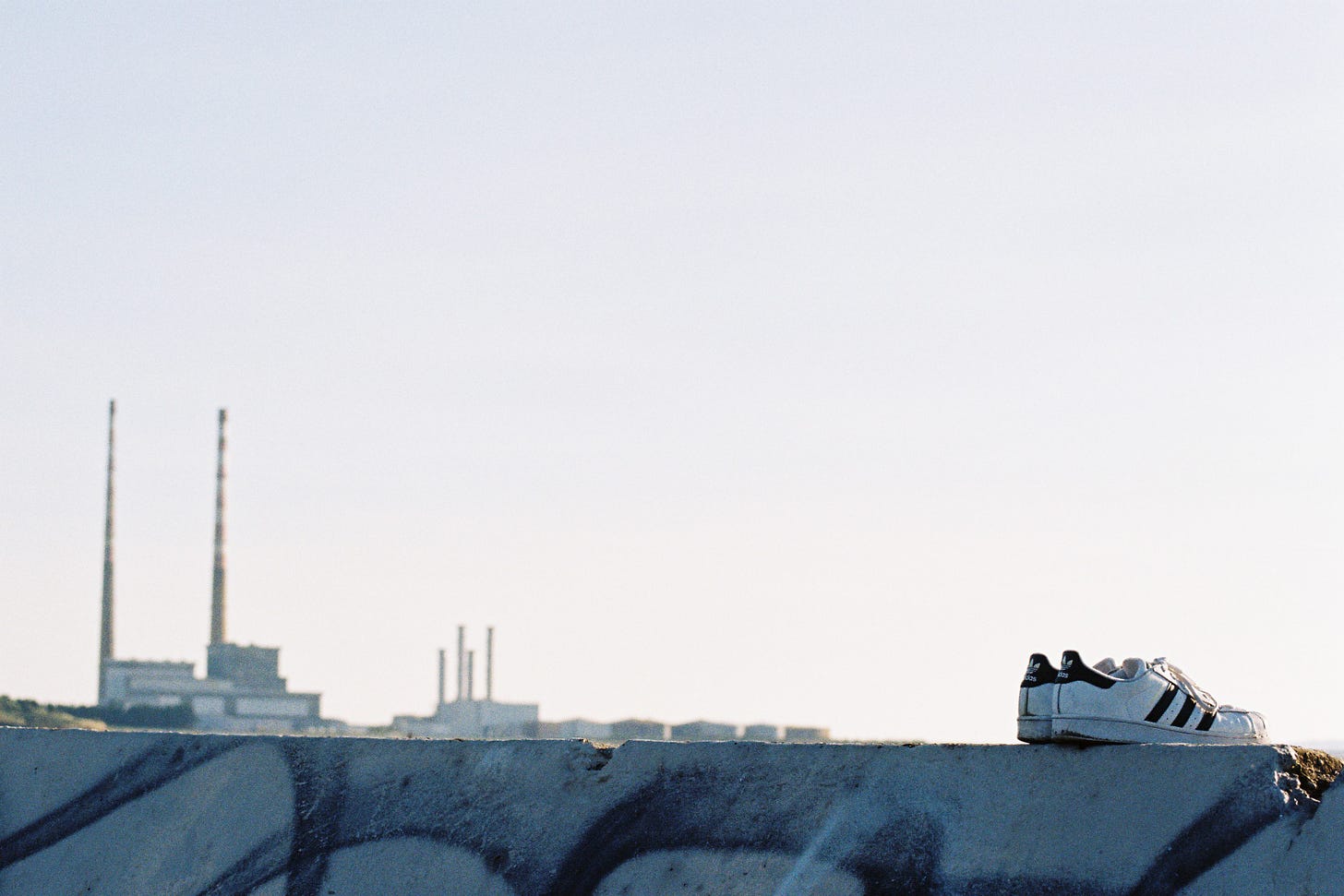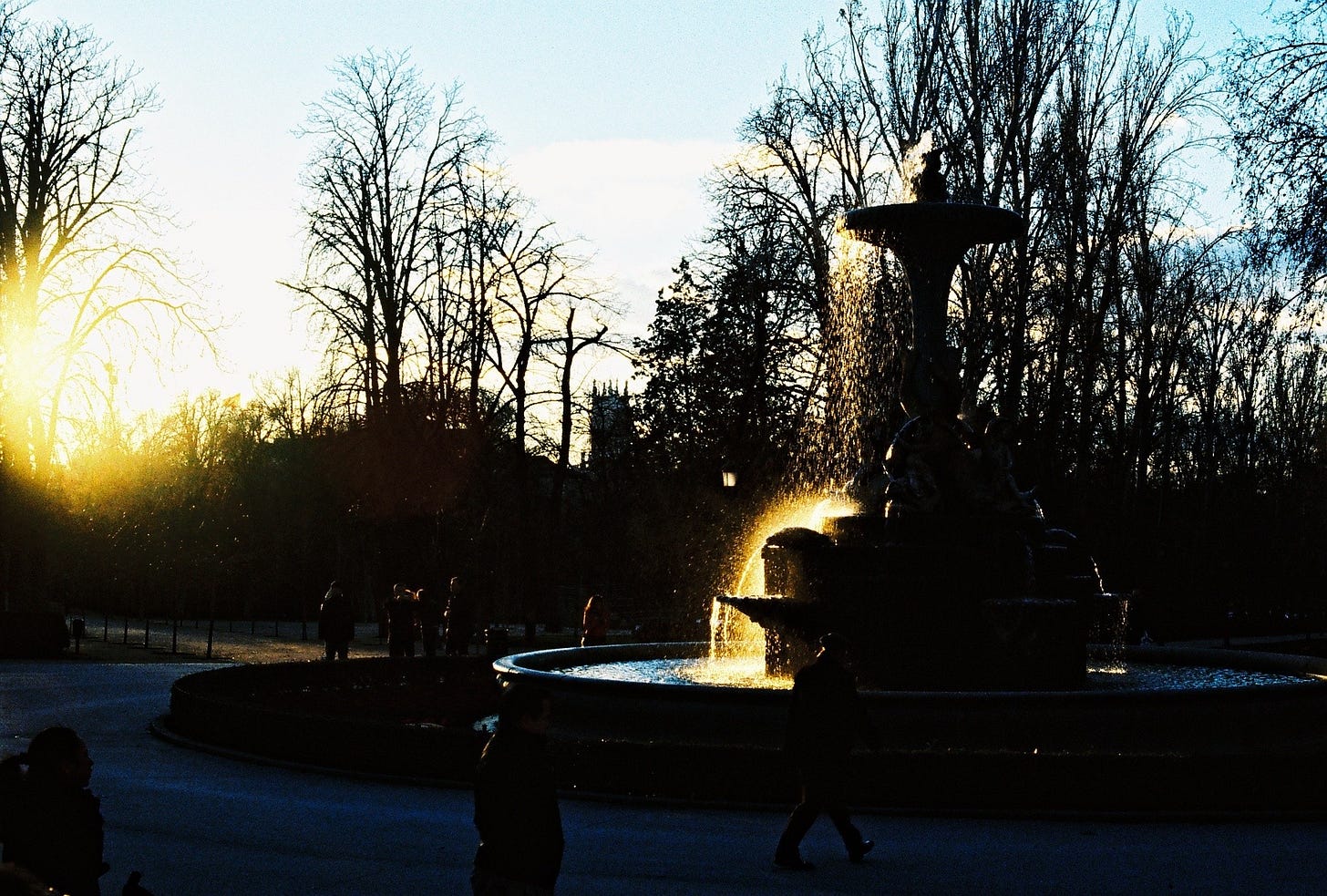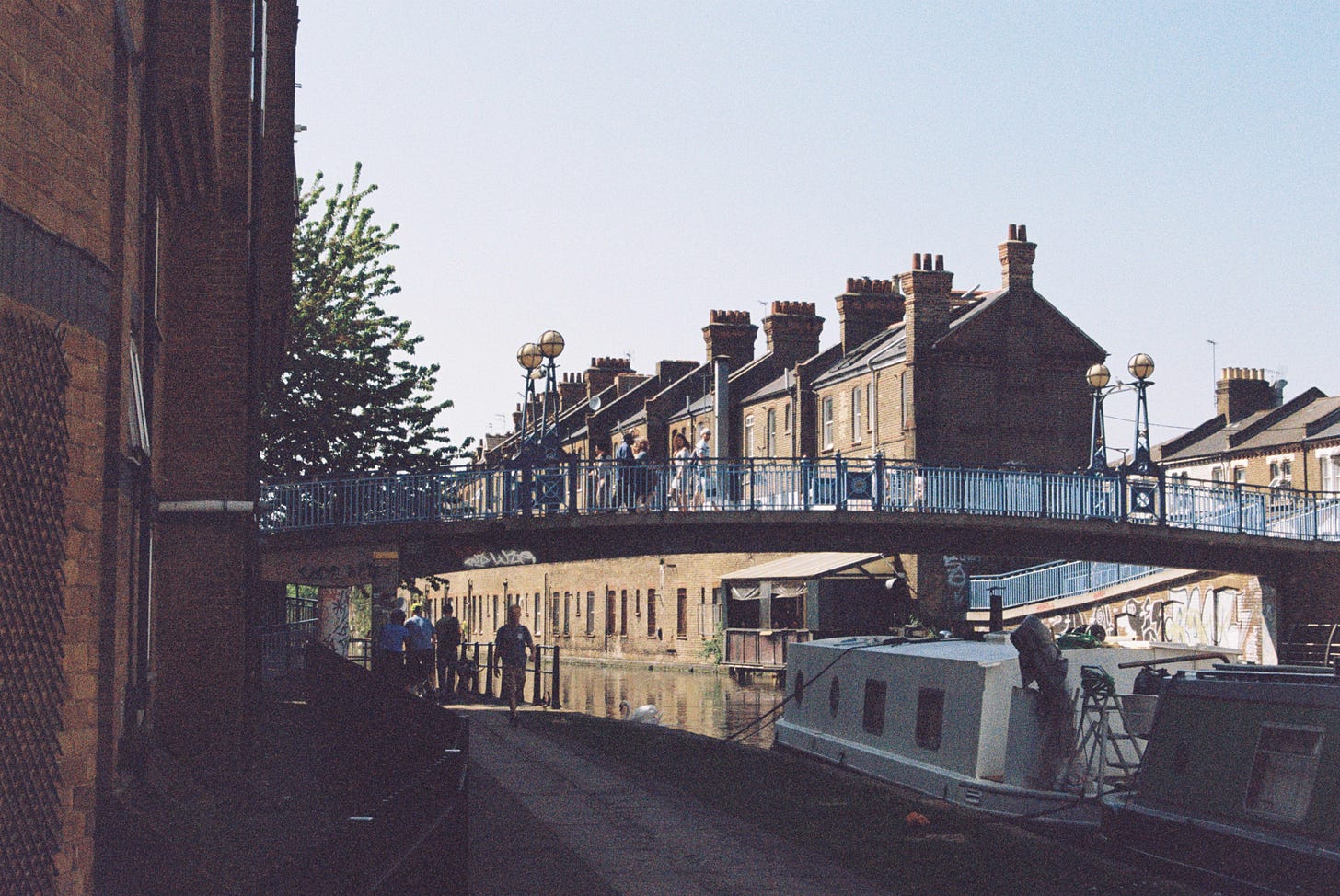#11 - "I Can Read the Writing on the Wall"
Analogue photography and memory
I’ve had a busy couple of weeks writing wise, with a short story (Gleanings) out at the London Magazine and three non-fiction pieces in quick succession at the Irish Times on rebel music, housing, and Fianna Fáil. Gleanings is a story I wrote almost five years ago, and which had been rejected from dozens of places. It’s a fairly grim revenge story. I’m really selling it here. I stuck with it because I loved it, which is enough reason to do anything, really.
I’m still open for commissions at jackosiochain@gmail.com.
I started shooting film – taking photos on 35mm – in the summer of 2012, a couple of months after Kodak declared bankruptcy. I was living in New York City, unemployed, stop me if you’ve heard this one before. I had started to feel that without a focus, the days were slipping away from me, forming no permanent residue of memories. The question arises in these pivotal moments in your life: what if you have no epiphany? What if nothing happens to you? What if you go on a journey and return exactly the same as you were? Well, you can always take pictures, and then at least you’ll have something to point to.
A basic digital point-and-shoot cost a few hundred dollars, which I didn’t have. A cheap plastic film camera cost exactly $48.50 (about three and a half packs of Newport cigarettes), including a roll of Lomography Lomo 400.1 My friend, exasperated on seeing the bright blue Holga, sighed, “please tell me you didn’t buy a camera in Urban Outfitters.” I had.
(New York, 2012)
The Holga was a Chinese-made bargain basement camera, originally for larger 120 film. By the times I bought one, the 135 model was a fashionable accessory for cool kids in Berlin and Brooklyn.2 I used it, inexpertly at first, to document my walks around the city. Interesting graffiti, the Brooklyn Bridge at sunrise, the distant speck of the Statue of Liberty in the blurry 47mm lens.3 Yes, all these things were clichés, but they weren’t clichés to me then.
(The downtown Manhattan skyline, 2012. One World Trade Centre, unfinished, is visible in the right of the picture)
But wait, that’s not true. I started shooting film years earlier, in 2004, on an Olympus Trip 35 owned by my aunt. I took pictures of a bog in Wexford, and a few gaelic football matches at my secondary school, where other kids made fun of me for using a camera from the eighties. They probably didn’t even make fun of me that much, but my pride didn’t allow me to continue, and so the camera went back, dreams forgotten.
Actually, even that isn’t true. When I was nine, my cousin bought me a disposable, probably a Kodak Funsaver. I shot the 24 or 36 exposures and then, lacking information on what to do next, dismantled it with a screwdriver from a Christmas cracker. What can I say, I wanted to know how it worked. I gave myself several medium-sized electric shocks from the exposed flash capacitor and tossed it fearfully into a corner, where it lay for months, mysterious, ominous, a source of pain and no photos.
Back to New York. Film was cheap, development hard to come by. It was the era where serious photographers were offloading their analogue equipment for a tenth of what it cost, clearing out their freezers of old emulsions, chucking apparently worthless accessories in favour of a new, digital workflow. The clunky, expensive and inferior DSLRs of the early ‘00s were gone, and cameras like the Canon 5D Mark II and Nikon D90 were hegemonic.4 People always wanted to know why you were bothering with this old stuff. I once bought a dozen disposables from a man on the internet for less than a fiver, which I handed out to my baffled and often non-receptive friends, many of whom had perfectly acceptable cameras on their phones.
(Dublin, 2017)
Back home I discovered that my dad had a still working Pentax Super ME, a severely underrated early-eighties, Japanese-made SLR with a bright, enormous viewfinder and neat, tactile dials. I walked my way through the basics of photography again, the exposure triangle, the sunny 16 rule, every mistake a joy, every successful picture a miracle. I was laughed at again, but in a friendlier way this time, with an edge of slight longing when I let people focus and fire, showed them the plastic negative sleeves they remembered from early holidays to the Algarve. I found a photo lab that still did processing, not begrudgingly but enthusiastically. I’ve still never found a lab anywhere in the world the equal of John Gunn’s on Wexford Street, and probably never will.
So why film over digital? There is no answer to give to that question that doesn’t sound ludicrous, pretentious or questionable. As with the audio debate, it’s impossible to avoid getting into subjective arguments about the “feel” of analogue. Like most new technologies, digital did not take over because it was better, it took over because it was cheaper, more efficient. It took over in part because it could and would destroy jobs and thus concentrate profit upwards. Digital is endlessly scalable and transmittable. At the consumer end, it requires little infrastructure or skilled labour. Quietly, almost invisibly, the position of lab technician basically ceased to exist. Slowly even positions around photography – photojournalists, travel photographers – began to erode as ever greater numbers of people began taking pictures.
(Porto, 2018)
But the aesthetic argument can’t be avoided, so I’ll lay my cards on the table. Digital photography may be technically more precise, but analogue remains more human. It is in the failures and the flaws where film excels. Like the difference between the warm fuzz of scratched records and the screech of mp3 distortion, digital noise is alienating, analogue noise is lovely. Zoom in close on a digital picture and all you will find are individual pixels. There is a reason that the last twenty years have seen dozens of efforts, from camera and app makers, to replicate the warm grain of emulsion. Digital photography is ugly in so many ways, and only beautiful in a few. Digital amateurism is anonymous, ubiquitous, the mounting slush on every device. Analogue amateurism is charming at the very least. Think of how your eye slides over thousands of digital images, of concerts and food and sun holidays, to settle on a faded, flash-lit snap of someone’s parents, grinning, permed and moustached, in the 1980s. On the rare occasions now that someone bothers to shoot a feature film on 35mm (Asteroid City, Liquorice Pizza), the reviews inevitably note how rich and gorgeous it looks, so different to the weightless, antiseptic digital pictures we have all been fed since the turn of the century.
(Hue, 2019)
The price of film has climbed vertiginously since the mid-2010s, when you could buy a roll of cheap Agfa 200 for €1.50, and develop it for €8. Blame supply chains, blame the price of materials, blame price gouging. It doesn’t really matter, this is a hobbyists world, and we’ll keep buying that garbage. Unlike vinyl LPs, making film is complicated, expensive, and reliant on machines for which there is no longer much of a mass market. Film manufacturing at any reasonable scale rests in the hands of a small number of corporations. With the honourable exception of Ilford, these companies appear to care very little about their creations. Fujifilm, in particular, have an almost vandalistic attitude towards their beloved colour film lines, discontinuing them at will, without notice or explanation. Is it profitable? It doesn’t matter, because it doesn’t fit in with a business plan that lies outside of any democratic control. If they want film dead, they will kill it. Film photography is a fatalistic pursuit, where you stock up your freezer and wait patiently for a company to vanish the tools with which for decades you have built your art, never to be seen again.
(Madrid, 2013)
Photos are adhesive, memories build up like sediment around them, with all their attendant distortions and evasions. One photo, taken at the right moment, can provide the structure for your recollections of a day, a whole month, a whole year, an entire person. The times in the last ten years where I have lacked the money or the will to shoot are also the times that I remember the most indistinctly. I have no grip on particular seasons or some years without the hard anchor of a sloppily taken group shot, a landscape marred by smoke, a quiet moment on a city street. They are mine to keep.
(London, 2017)
And it looks better! It looks better. We are now past the era where it was customary to label a vast quantity of cultural outputs, clothes and affectations as “hipster”. Film photography sat comfortably in this world, alongside artisanal axes and drip coffee and fussy facial hair, and we all laughed, but in the clear light of morning I’m afraid they were right. It looks better! Notice how affection for film has been seamlessly transmitted to Gen Z, even as they discarded the rest. Some of them do not even remember the original era of film, but something speaks across that divide. They spent 150 years perfecting the chemistry of film, you can’t expect them to get digital right in less than 30.
As emulsions are discontinued, the hardware supporting film photography continues to age. Few new film cameras are made in 2023, and those are either prohibitively expensive (think Leica) or essentially plastic toys. Pentax whisper of a new midrange SLR but in the mean time we take care of our cameras and try to fix the parts that stop. The foggy mirrors and cracked seals, the grinding focus wheels and shorting eighties electronics. Five years ago, my wife took an Olympus OM-2 out of storage in her native Arizona. It had lain in the bone dry climate, ageless for decades. A few months on the road in Ireland and Asia made it cough and splutter to a halt. The batteries on another camera were mercury, and the technician told us that not only was he unable to replace them, he couldn’t even let us leave the shop with the ones we had.
I am not a professional photographer, in the sense that I don’t do it for a living. I certainly take it seriously, more seriously than almost anything I do. But I have an uncomplicated love for it that I don’t for the things that I rely on for income: writing, research, etc. Give me enough film and money to develop it and I will happily make images forever. The same thing that puts me off digital also repels me from professionalisation: the need to streamline a workflow. The need to spend hours in Photoshop and Lightroom, messing with curves and tones and generally becoming more of a manufacturer of pictures than an artist. I have shot exactly one wedding in my life and it was equal parts wonderful and stressful.
The mounting costs have limited the amount of film I can shoot in the last few years. I’ll probably get a digital camera at some point, for less important occasions, for convenience, out of curiosity. But then, I’ve been saying that for years. I’ve watched systems come and go, seen millions of digital images and rarely been grabbed enough to consider buying in.
Everyone becomes a collection of sentimental clichés at some point, so here are mine: there is still nothing in digital photography to compare to the excitement of getting developed images back. The thirty-six or thirty seven moments you grabbed, some blurry, some poorly composed, some incoherent, some you didn’t even remember. And a few that help you stay connected to the life you’ve led, that help you remember.
(Dublin, 2021, Photo taken by the incredible Ivana Patarčić)
Reading – Elena Ferrante, My Brilliant Friend (2012)
Watching – Video updates on the California High Speed Rail project
The number after a film stock indicates the ISO, or light sensitivity. Lower numbers indicate that you need more exposure time, or a larger aperture size, to compensate. In the mid-century heyday of film, “slow” emulsions were rated about 25-100, “fast” about 200-800. Slower films are in general more fine grained, better for precise work, whereas fast films are good for low light and difficult conditions. The fastest colour film commercially available when I started was the unequalled Fujifilm Superia 1600 (deceased 2017). Ilford still make a 3200 B&W film, the grainy but gorgeous Delta 3200.
The number here denotes the “format” or size and type of film. The vast majority of analogue still images these days are taken on 135 (35mm) film or 120/220 (medium format) film. Some professionals also use larger formats like 4x5, and it’s still just about possible to shoot some more niche sizes, like 110 or APS.
The 47mm here refers to the focal length of the lens, with a smaller number being a wider lens, i.e. one with a wider field of view.
DSLR stands for Digital Single Lens Reflex. The Single Lens Reflex camera, both film and digital, was one of the most popular camera types from the 1950s through the 2010s, when mirrorless systems began to replace them. At a basic level the SLR is a system whereby the user looks through a viewfinder at a series of mirrors that show exactly the image that will be taken. At the time the shutter is pressed the mirror moves, allowing light to fall on the film or sensor.








